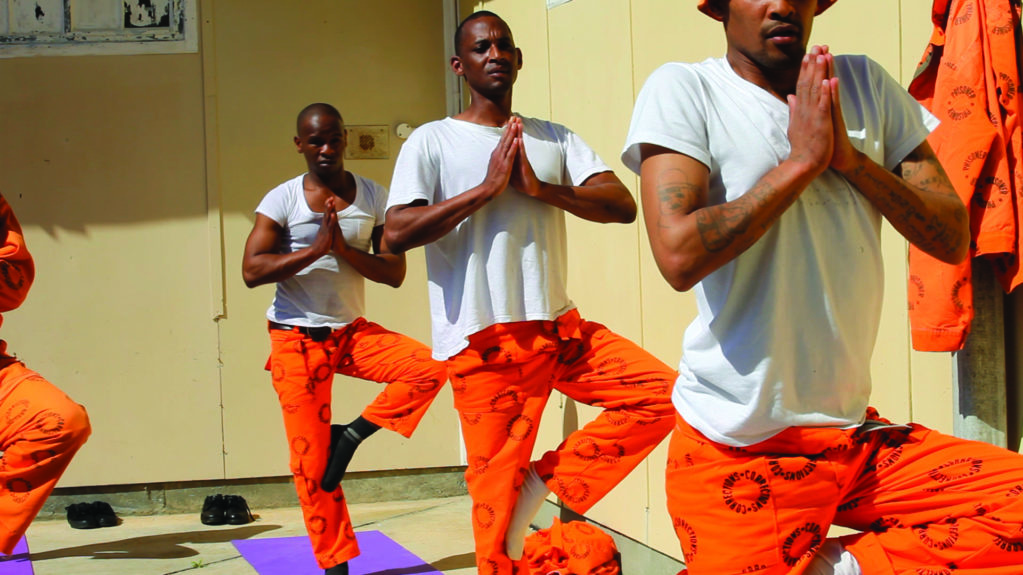Yoga, which enjoys iconic status as an exercise form in today’s bustling metropolises, is a practice that dates back 5,000 years to the Indus-Sarasvati civilization of northern India. It is popular for its countless healing and rehabilitative benefits. Cape Town-based yoga practitioners Brian Bergman and Leela Codron thought: why not take it to prison inmates?

Through SevaUnite, a non-profit organization based in South Africa’s Mother City, the two are now popularizing yoga’s downward dog pose and meditation in some of the country’s most prominent prisons.
“A group of yoga friends wanted to set up something that provided a platform to encourage people to follow the path of Seva yoga or self-esteem service as a means to self-development,” says Bergman, the founder of SevaUnite.
‘Seva’ is a Sanskrit word meaning service. SevaUnite identifies ways to selflessly serve.
“We always had an interest in doing prison work so we put out feelers but nothing really happened until Leela came back after spending a year at the ashram in India where we trained in this particular style of yoga. When she came back, we decided to go full time into doing the Seva project, that’s when things started to roll,” he says.

With close to 200,000 inmates currently incarcerated in South Africa, they began at the Pollsmoor Maximum Facility in Cape Town – notorious for housing gang leaders and hardened criminals.
In his autobiography, A Long Walk to Freedom, the country’s late president Nelson Mandela, who has also served time in the prison, states “Pollsmoor had a modern face but a primitive heart”.
“It took us about a year to get into Pollsmoor initially. Just trying and knocking on their doors and we finally got granted access in 2011 and the project has just gone like that, us spearheading it and pushing it and slowly listening to all the signs and following them, we grew the project,” says Bergman.
Starting with one yoga class in the admissions center of the prison, the project has now expanded to classes in the male juvenile section and the women’s unit. SevaUnite also offers weekly classes at the Malmesbury Medium Facility in Cape Town and Kgosi Mampuru II Prison in Pretoria.
“The inmates have always responded well, they’ve always really loved it. It’s the staff that has been a bit tricky. You get mixed reactions because of the misconceptions of yoga – that it’s a religion or only practiced by certain kinds of people. We also get mixed responses from the public where a lot of people feel that prisoners don’t deserve this type of program or luxury so to speak,” he says.
Bergman and Codron eschew the notion of yoga being luxurious or a passing fad. Yoga is discipline; it’s about harmonizing the body with the mind and breath through breathing techniques (as the first United Nations’ International Day of Yoga on June 21 demonstrated).
“We teach a much more integrated holistic approach which brings in a huge amount of mindfulness and incorporates a big body of yoga knowledge and at that level it becomes much more transformative. You see that with the prisoners, it does create that transformation in them, it rehabilitates,” says Bergman.

Unlike mantra meditation, which involves focused concentration on a particular word or sound, mindfulness achieves a relaxed, non-judgmental awareness of your thoughts, feelings and sensations.
“You do one class and you immediately feel the effects of it. In a place that’s very stressful, intense and overcrowded and just not a nice place to be, anything you can do for yourself, to make yourself feel better immediately is going to be well received,” adds Codron.
As the saying goes, “the only difference between saints and sinners is that every saint has a past while every sinner has a future”, Bergman is hopeful he will see some positive changes in the future.
“They are making that transformation where they may have done something wrong and were considered sinners but they’ll come out like saints. There are a few of those guys that I can’t wait to see on the outside and see what they do with their lives,” says Bergman.
The prison gangs in South Africa are intricate – and fearsome. The Numbers Gangs make up three gangs in prison – the 26s, 27s and 28s. The 26s are scammers and counterfeiters, the 27s are ‘Manskap of blood’ or murderers and criminals, and the 28s are sex offenders.
Prisoners network into gangs in relation to their offence. The Number Gangs take their inspiration from the real historical figure who founded them, Nongoloza Mathebula, an early Johannesburg bandit who built a quasi-military band of outlaws, welding his small army together with a simple but potent ideology of banditry-as-anti-colonial-resistance.

“In Malmesbury, we’re apparently teaching some notorious gang leaders but we didn’t even know, that’s how different they appear to us. You can see they’ve got tattoos – 26, 27 and 28 all over them but they are such amazing men. So open and very honest, their development since August is phenomenal,” says Codron.
“It’s a constant dance between connecting with people who on one hand are completely different from you but on the other hand are exactly the same.”
From gangsters to gurus, the inmates know one thing for sure – that yoga is ‘time’ well-spent.
